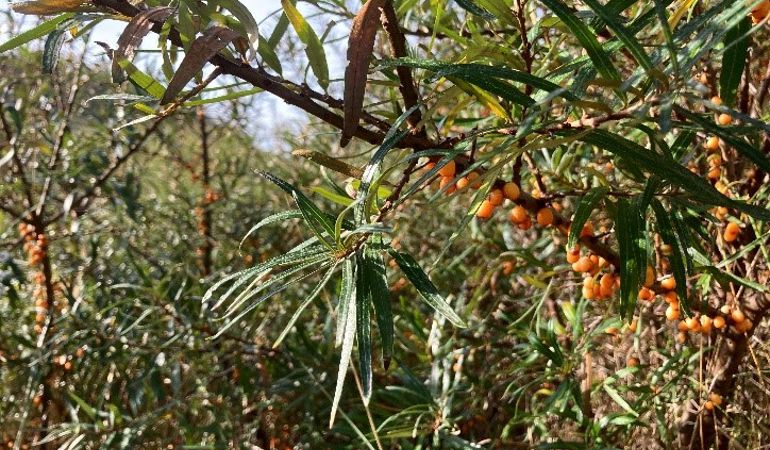Specialist wildlife gets a boost as scrub is removed across Pembrey sand dunes

This December, large areas of invasive plants including sea buckthorn that are damaging the health of the iconic sand dune system will be removed. This will help to create a better environment for wildlife and rare plants, and ensure that this coastal landscape is more resilient to future challenges such as climate change.
Coastal sand dunes are listed as the habitat type most at risk of biodiversity loss in Europe, and in many cases the decline in habitat health is due to uncontrolled vegetation growth. Scrub smothers the sand dunes and has a devastating effect on the specialist plants and invertebrates which live there, many of which are adapted to live in bare or moving sand.
The coast around Pembrey is home to 20% of all the plants in Wales and features a large sand dune system which is currently facing issues with over vegetation. The growth of dense thickets of sea buckthorn – a fast-growing plant which isn’t native to the Welsh coastline – is a particular problem. If scrub growth is not controlled, it will cause species like lizards, orchids and dune pansies to suffer and even disappear from these sand dunes.
This winter Natural Resources Wales (NRW) will be removing dense non-native sea buckthorn, using large specialist machinery from the Pembrey Forest and Pembrey Country Park areas of dune to help wildlife thrive.
This work is undertaken as part of the Dynamic Dunescapes project, supported by National Lottery Heritage Fund and delivered in Wales by Natural Resources Wales (NRW). NRW is working at Pembrey with Carmarthenshire County Council’s Outdoor Recreation Service to improve the condition of these dunes for wildlife.
The first phase of this work is to take place in Pembrey Country Park adjacent to Car Park 8 and close to the old fisherman’s car park and the second will take place on the foredunes owned by NRW in front of the forest. It is scheduled to begin on the 5th December and will last for two weeks. There will be a temporary closure of Factory Road outside the Country Park for one week – reopening on 10th December.
Hannah Lee, Wales Engagement Officer for Dynamic Dunescapes, said:
“Being able to clear dense scrub and invasive species like sea buckthorn from a site like this is really important in ensuring this beautiful space has a thriving future. It creates space for all the incredible species that can only live in sand dune habitats, and this work prevents the vegetation from sweeping across large parts of the dunes in the coming years – they’re plants that can grow very quickly if we don’t manage them.”
Scrub removal will help to restore the habitat types that these species need, and this work will play a part in ensuring the dunes at Pembrey have a healthy, biodiverse future. Improving the ecological condition here will increase this coastal landscape’s resilience to other threats, such as extreme weather events and changing conditions brought on by climate change in the future.
Ruth Harding, Senior Environment Officer at Natural Resources Wales, said:
“Sea Buckthorn control is important to improve the dune grassland habitats at Pembrey. Carmarthenshire County Council and Natural Resources Wales have carried out this type of habitat management over a number of years which has resulted in restoring the area to a dune grassland rich with different species of plant. You can best enjoy this during the summer months within the Pembrey Burrows and Saltings Local Nature Reserve. As part of Dynamic Dunescapes, we are now continuing this work, which will result in an overall increase in dune grassland habitat.”
Carmarthenshire County Council’s Cabinet Member for Regeneration, Leisure, Culture and Tourism, Cllr Gareth John said:
“We are pleased to be able to continue with the important work of returning our dunes to a condition which will allow the appropriate sand dune biodiversity to improve. The removal of the invasive Sea Buckthorn is fundamental to this process and, whilst the initial work may look drastic, it is necessary to ensure as much of this tenacious shrub is removed as possible.
“Disturbing the ground will invigorate the existing seed bed, with the result that a wide range of wildflowers and grasses will re-establish and begin the process of increasing the biodiversity of the dunes at Pembrey.”
Dynamic Dunescapes is not the only project working to restore Pembrey’s important sand dunes. The EU LIFE-funded Sands of LIFE project, managed by (NRW), has also been undertaking sand dune management to improve conditions for wildlife in recent years. The two projects work closely to build on and support each other’s work.
